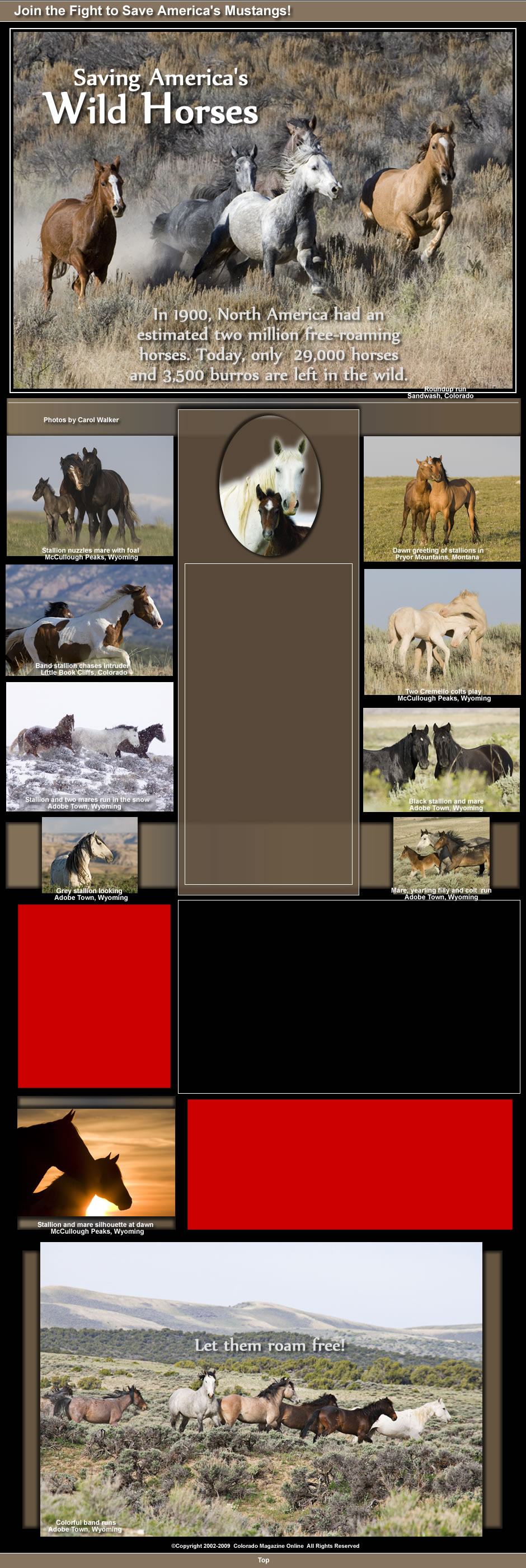“Dust boils up off the prairie. In a land that seems empty of all but sagebrush, wisps of grass, dirt and sun…moving shapes begin to take form: white blazes, flashing eyes, manes flying and tails waving, the occasional sharp hoof. There is sound too, a gradually growing dull thunder that vibrates the ground like an enduring earthquake. Soon dust, shapes, and sounds resolve themselves into running horses—a huge number of running horses.”
–
from the introduction to Wild Hoofbeats - America’s Vanishing
Wild Horses
by author Carol Walker
This story traces the history of Mustangs in America and tells what is happening to them today. It provides an update on their current status with regard to congressional legislation, which will determine their destiny. It describes range management by the Bureau of Land Management (BLM) and illuminates the brutality involved in BLM contracted roundups to reduce their numbers on public lands. It also describes the ongoing efforts by concerned citizens,such as Madeleine Pickens, who want to save the lives of these wild, wonderful and beautiful creatures, who proudly represent the free spirit of America’s heritage.
The independence and very existence of these wild horses was undermined in December 2004, by the unconscionable and cruel action of Conrad Burns, the former Republican Senator from Montana, when he slipped a last minute amendment into a 4,000 page appropriations bill. His amendment, which went unnoticed by members of Congress, lifted a federal ban on the sale and slaughter of wild horses and burros - animals that had been protected by the US government since 1971.
That amendment was prompted by the Bureau of Land Management‘s concern - influenced by the cattle industry - that the wild horse herds are depleting land where privately owned cattle also graze.
As a result of that amendment, the bureau was authorized to round up and sell thousands of wild horses. This outrageous legislative amendment exposes a risk, that despite assurances from the BLM it would only sell horses to buyers who had an interest in their welfare, some of the horses might be slaughtered for their meat, which would then be shipped overseas. This fear has become a reality because some horses bought at auction have been taken to Mexico to be slaughtered.
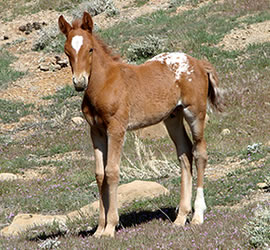
Appaloosa Colt - "named Traveler - because
he travels around to several different areas
on the range, unlike other Mustangs that
remain in only one area."
Photo and comment by Billie Hutchings
Little Book Cliffs, Colorado
Today’s free-roaming, wild American Mustangs are descended from horses, which were originally brought to North America by the Spanish Conquistadors in the late fifteenth century. Although they are commonly referred to as wild horses, they are actually feral horses, or previously domesticated horses, which have reverted to the wild. The English word "mustang" is derived from the Spanish word, mesteño, meaning "stray" or "feral animal.” The Spanish horses were of Andalusian, Arabian and Barb ancestry. As Native Americans adopted the use horses for transportation, herds multiplied throughout the Great Plains and the West. The U.S. cavalry, ranchers and miners also needed horses and many were trapped and trained for their use. Until as recently as the mid-twentieth century, unneeded horses continued to be released onto public lands by those groups.
According to archaeologists, early predecessors to modern day horses actually evolved on this continent in prehistoric times, then migrated across the Bering Land Bridge and completely disappeared from the continent between 11,000 and 13,000 years ago.
It is interesting to note, in light of the existence of the original ancestors of horses that lived in the Americas during prehistoric times, that many Indian myths and stories about the return of horses to the Americas reference "the grass remembered" theme.
By 1900, North America had an estimated two million free-roaming horses. Since 1900, the Mustang population has been reduced drastically. Mustangs were viewed as a resource that could be captured, used, sold or slaughtered for pet food or other uses.
During the 1950s a Nevada woman, Velma B. Johnston - later known as Wild Horse Annie - became aware of the ruthless and indiscriminate manner in which wild horses were being gathered on the rangelands by ranchers and hunters, known as "mustangers." They played a major role in harvesting wild horses for commercial purposes.
Wild Horse Annie led a grass roots publicity campaign, involving mostly school children, which outraged the public about the treatment of wild horses. Newspapers published articles, such as the July 15, 1959, Associated Press article, "Seldom has an issue touched such a responsive chord,” about the exploitation of wild horses and burros, "
That publicity resulted in Nevada Congressman Walter Baring’s introduction of a bill in January 1959, which prohibited the use of motorized vehicles to hunt wild horses and burros on all public lands. The House of Representatives unanimously passed the bill, which became known as the "Wild Horse Annie Act." The bill became Public Law 86-234 on Sept. 8, 1959. The shortsighted bill, however, did not include Annie's recommendation that Congress initiate a program to protect, manage, and control wild horses and burros. As public interest and concern continued to increase, it became clear that Federal management, protection, and control of wild horses and burros was going to be essential.
In response to public outcry, members of both the Senate and the House finally introduced a bill in the 92nd Congress to provide for the necessary management, protection, and control of the wild horses and burros. The Senate unanimously passed the bill on June 19, 1971. After some revisions and a few amendments, the House also passed the bill by unanimous vote. President Richard M. Nixon signed the bill into law on December 15, 1971. The new law became Public Law 92-195, The Wild Free-Roaming Horses and Burros Act of 1971, as amended. This Act was later amended by the Federal Land Policy and Management Act (FLPMA) and the Public Rangelands Improvement Act (PRIA).
The purpose of the Wild Free-Roaming Horse and Burro Act of 1971 was to protect, manage, and control wild horses and burros on public lands. The legislation declares that ". . . wild free roaming horses and burros are living symbols of the historic and pioneer spirit of the west... and enrich the lives of the American people.” It further adds that they should be "protected from capture, branding, harassment, or death."
The problematic aspect is that the same law also requires the government to achieve "appropriate management levels of roaming horses” so they don't overpopulate federal lands. The 1971 law authorizes the BLM to remove “excess wild horses and burros” from the range to “sustain the health and productivity of the public lands” and offer them to the general public for adoption to horse lovers, who promise not to sell them for slaughter. The BLM claims that because wild horses and burros have virtually no natural predators and because their herd sizes can double about every four years, it must roundup and remove thousands of animals from the range each year to control herd sizes. These roundups became aggressive under the Bush administration.
There has also been concern that Public Law 94-579 (FLPMA), dated Oct. 21, 1976, allowed the Secretaries of the Interior and Agriculture to use or contract for the use of helicopters and motorized vehicles (which terrorize the animals) - to manage wild horses and burros on public lands.
Since 1971, the BLM has adopted out more than 220,000 horses and burros. Currently there are just over 30,000 horses in holding facilities awaiting adoption.
Although the 1971 Wild Free-Roaming Horses and Burros Act, provides that all wild horses and burros in holding are supposed to be protected by the BLM under law, unfortunately, those animals10 years old or older, or those who have not been adopted after three tries, can be sold without restriction under 2004 legislation.
Since 2005, the Bureau has sold more than 2,900 horses and burros. The BLM claims it has not been selling any wild horses or burros to slaughterhouses or to "killer buyers." Question: Who are they sold to and for what purpose, if they could not be adopted out?
The BLM manages horses in 270 herd areas in ten states, but through its planning process it has now decided to only utilize 199 Herd Management Areas over the long-term. Wild Horses and Burros are found on Bureau of Land Management Public Lands and US Forest Service Territories in Arizona, California, Colorado, Idaho, Montana, Nevada, New Mexico, Oregon, Utah, and Wyoming. About half the Wild Horse & Burro areas are in Nevada.
Link
to BLM Wild Horse and Burro
Herd
Areas Map
www.blm.gov
According to information posted on the Bureau of Land Management ‘s website as of December 2008, it estimates that the current free-roaming population of 29,500 horses and 3,500 burros in 10 Western states exceeds by approximately 5,700 the number they have determined can exist in balance with other public rangeland resources and uses. According the BLM, the manageable level is 27,300 animals.
Jill Anderson,
Director of Development & Communications at the Return to Freedom, American
Wild Horse Sanctuary points out that over 6 million private livestock graze
on public lands. She states that to claim the land can sustain 6 million cattle,
but not 29,500 horses, "flies in the face of common sense," and
further notes that the BLM continues to claim an
overpopulation of wild horses, "without any sound science, census data,
or range studies to base this assumption on." The number has been arrived
at by a wild horse advisory board that is comprised largely of livestock ranchers,
who have a vested interest in how the land is used.
Virginia L. Parant of the American Wild Horses Preservation Campaign, a coalition of about 45 groups, also claims that the BLM does not use a scientifically sound method to estimate the size of horse herds or the number of horses that can be sustained on the range. “That makes the roundups arbitrary,” she said.
Horse advocates say findings of federal officials are tilted in favor of cattle interests, who claim that wild horses compete with cattle and wildlife for food and water.
According to Jeff Eisenberg, director of federal lands for the National Cattlemen's Beef Association, an industry-lobbying group, livestock people don't particularly seek euthanization, rather they seek management of the population.
The future of wild horses is becoming more tenuous now, as the Congress doesn't want to put more funding into the holding facilities, especially when the economy is in trouble. To further exacerbate the situation, the pace of adoptions has been falling as the cost of feeding and caring for the wild horses has skyrocketed, and to make the situation even more serious, about 19 million acres of land where wild horses once roamed have been removed from the program, which has minimized the amount of land previously available to wild horses. A report released by the Government Accountability Office called the situation a "crisis" and said the BLM needed to exercise its options, including euthanasia and the practice of selling the wild horses "without restriction," meaning they could be sold for slaughter.
Shelley Sawhook, president of the American Horse Defense Fund has said policymakers have to resolve the conflict between a law that permits euthanasia and a nation that is opposed to it.
Animal rights groups want the government to sterilize horses and return them to the wild to live out their lives. They say, it should offer tax incentives to landowners who allow wild horses to live on private land.
On a more
humane side of BLM operations, there are people who are concerned about the
Mustangs, such as Billie Hutchings, who is a volunteer worker on BLM lands
in the Book Cliff wild horse area. She loves the Mustangs and cares about
their welfare.
As a volunteer, Billie says, “ it’s part of my job to track the
herds and notice when mares change bands, when new foals are born, and when
horses change areas or disappear. We have names for all of the horses - they
have been tracked for many years. There is a lady here, known as the "Wild
Horse Lady" of the Book Cliffs. She has been watching the horses, who
roam here, for the past 30 years. That’s why we can tell which horses
are the sires of the foals and know the age of each horse.
Billie is a member of a local club, called, Friends of the Mustangs, which is a volunteer group for the BLM. They help the BLM with many tasks on the range. Billie said they keep the range free of trash and barb wire, fix fences and water tanks, and take care of anything else that needs to be done. They also participate in roundups,” which she said are now called “gathers.” The club also helps to decide on the names for new foals.” The Friends of the Mustangs club has a web site at: www.friendsofthemustangs.org
Billie has a blog in which she describes her trips to the range at: spaces.msn.com/wildhorsefever. She also places her many wonderful photos of wild horses on both her blog and on her Flickr site photo pages, at: www.flickr.com/photos/wildhorsefever
She said she is on foot when she photographs the horses. She explained, “Sometimes they are not easy to find and we do a fair amount of hiking to get to them, but it is worth every minute!” Billie said her feelings about her experiences on the range with wild Mustangs are pretty much summed up by one of her favorite quotes by John Burroughs, "I go to nature to be soothed and healed and to have my senses put in order.” Regarding the harsh realities of the politics which surround the wild horses, Billies added, “The horses don't understand the politics of the whole deal, they just live each day free as they have for many years.”
There are a number of organizations and individuals dedicated to saving wild horses, among which is the Black Hills Wild Horse Sanctuary in Hot Springs, South Dakota. It was founded by Oregon rancher, naturalist, and author, Dayton O. Hyde in 1988, after he convinced the Bureau of Land Management to send him its unadoptable wild horses.
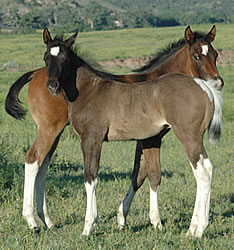
Foals
at play, at the
Black Hills Wild Horse Sanctuary
Funded by The Institute of Range and American Mustang (IRAM), it owns 11,000 acres of private land, which are dedicated to range preservation and a balanced ecosystem. The Sanctuarys, purpose is to provide space where unadoptable and unwanted wild horses can run free and live quality, protected lives. Over the past twenty years, its herd has grown to between 400- 450 wild horses. Operated by a staff of volunteers, the sanctuary is also involved in research devoted to understanding wild horse herd management problems and to the development of solutions, which may contribute to the well-being of all wild horses.
The public is invited to the sanctuary, which Hyde describes as a, “grassland home of rocky canyons, wind swept prairies and dark pine forests, where coyotes, cougar, white-tail and mule deer, elk, wild turkeys, eagles and falcons share the land with the wild horses, who roam free here.” Visit the Black Hills Wild Horse Sanctuary website at: www.wildmustangs.com
Another organization that saves horses - both domestic and wild is Colorado Horse Rescue, located in Longmont, Colorado. It is a nonprofit organization dedicated to providing shelter, emergency relief, care, rehabilitation, and adoption services for abused, abandoned, neglected and unwanted horses. CHR also provides community resources through equine education, counseling, information and referral services. The organization is funded through individual donations, grants, bequests and corporate sponsorships. Visit Colorado Horse Rescue’s website at: www.chr.org
Return to Freedom, in Lompoc, California is a non-profit wild horse sanctuary founded in 1997 by Neda DeMayo, dedicated to preserving the freedom, diversity and habitat of America's wild horses through sanctuary, education and conservation.
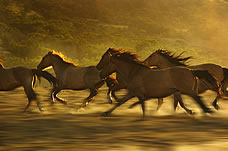
Wild
Horses run free at the Return to Freedom Sanctuary. Rounded up from the Sulphur
Springs Herd Management Area in Utah, the Sulphurs possess DNA that is genetically
similar to the primitive Iberian Sorraia. It is believed that there are fewer
than 60 left in the wild. This is just one of the rare genetic strains of
America’s wild horses that is in danger of becoming extinct in the wild.
Tony
Stromberg photo
Return to Freedom provides a safe haven sanctuary for nearly 200 wild horses and burros recognizing that wild horses live in tightly bonded herd groups, Return to Freedom became the first sanctuary with a focus on rescuing entire family bands. Designed to be a model program, the sanctuary implements alternative and minimally intrusive management philosophies. Visit the website at: www.returntofreedom.org
Neda DeMayo, Return to Freedom's founder notes, "America's wild horses have survived centuries of change as industry and urbanization have decreased our open spaces and wilderness areas. They have been relegated to the most inhospitable areas of our western landscape, as private livestock lay claim to our public lands. And yet they have adapted. If we allow the wild horse to disappear form the wild, and scatter the remaining herds to barns and backyards around the country, we will interrupt hundreds of years of an evolutionary journey. If we allow this to happen, the wild horse will eventually become extinct in the wild and we will lose something that we can never get back."
The rugged life of the only wild horse herd
remaining in the state of Montana and the threat to its existence is documented
in two PBS films by Emmy Award winning filmmaker and author, Ginger Kathrens.
"Once there were other herds in Montana," remarked Kathrens, "but
like so many of our herds, they're gone now."
Kathrens’ two films and books document the story about Cloud, a beautiful
pale palomino stallion and his band of majestic Mustangs, who roam the Pryor
Mountains in Montana. She has filmed him from birth. Kathrens’ third
Cloud program, “Cloud: Challenge of the Stallions,” will
premier on PBS this Fall 2009 and her latest book will be published this summer.

Cloud
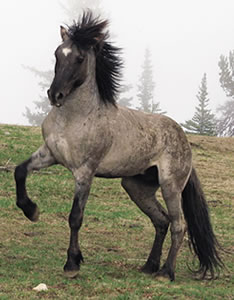
One
of Cloud's sons, Flint,
a bachelor stallion.
Photos by Ginger Kathrens
Kathrens and others formed The Cloud Foundation in 2005. TCF is dedicated to preserving Cloud's famous herd and other wild horse herds in the west. "We've lost 40% of our wild horses just in the past eight years," Kathrens comments. "19.4 million acres have been taken away from wild horses, even though these lands were designated as their homes in the early 1970s. If we don't act quickly we could lose our wild horses forever."
Visit
the Cloud Foundation at:
www.thecloudfoundation.org
Kathrens points out that the recent GAO report confirmed there are currently more wild horses living in government holding facilities than in the wild. "The healthiest of these captive mustangs deserve a chance to roam free again," she states. "Releasing the wild horses back on the millions of acres once designed for their use is the cheapest and kindest way to avoid euthanasia by the BLM."
"We need to step back, take a deep breath, and embark on a new path in regard to wild horse and public land management issues," Kathrens concludes. "If we are to restore wild horse herds to self-sustaining levels we need to look at retiring livestock grazing permits on wild horse herd areas, removing the many miles of restrictive fencing, protecting predators that can keep wild horse herds in balance with the land, and improving western ranges devastated by more than a century of over grazing by livestock."
Another
film company, Voluntary Instinct Productions, has also produced a series of
provocative documentary films, directed by Robyn Day, which expose the mistreatment
and plight of wild horses in America. Visit these links to view the films:
www.youtube.com/user/VoluntaryInstinct
www.voluntaryinstinct.org
Carol Walker, author and wildlife photographer has also taken up the fight to save wild horses. When she began photographing wild horses four years ago, she followed several herds in Wyoming, Colorado and Montana and became aware of how precarious their situation on public lands has become. Since then, she has dedicated herself to educating people with her photographs and stories about wild horses.
She has written an excellent photographically illustrated book, Wild Hoofbeats, America’s Vanishing Wild Horses, which describes the characteristics and lives of wild horses and deals with the tangled political issues surrounding their welfare and very existence. Her book explores how the BLM’s has mismanaged its responsibility to protect them and implores American citizens to take action to stop the massive removals of the already declining wild horse population in our country.
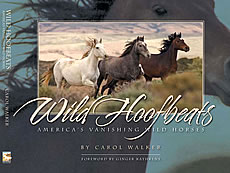
Carol states, “America’s magnificent wild horses represent our heritage as symbols of freedom and they are the last living icons of the old West. Their ability to survive against all odds should be cheered and they should be prized, not destroyed!”
Carol has traveled all over the world photographing
wildlife for the past 28 years and her wild horse photographs offer vivid
images of America’s precious heritage. Wild Hoofbeats is available
in bookstores and from Carol's website at: www.wildhoofbeats.com
Another notable effort to save wild horses is being made by Madeleine Pickens,
the wife of billionaire T. Boone Pickens. Lifelong animal lovers, the Pickenses,
a few years ago, led the fight to close the last horse slaughterhouse in the
United States. Historically, 100,000 horses a year had been slaughtered.
Madeleine is currently in the process of developing major plans to adopt, not just the doomed wild horses but most or all of the 30,000 horses and burros being kept in federal holding pens.”
Outraged by the BLM’s inhumane handling of wild horses, Pickens said, "Can you imagine somebody suggesting that you euthanize 30,000 horses? It is an abominable idea!" She added, "That will never happen.”
She wants to move the threatened horses from the holding pens to a one million acre wild horse sanctuary somewhere in the west. She is currently researching land options and working with the BLM staff to adopt the horses." She said, “Although there will always be the need for some short term holding for gathering, the idea with this sanctuary is that it will alleviate the BLM of all the costs of gathering the horses and placing them in holding pens.” After they are gathered and vaccinated or neutered, they would be brought to the sanctuary, where we would take control and manage them.
Madeleine Pickens pointed out an example of a sad situation at a short term holding facility in Fallon, Nevada. “At the holding facilities there, she said, “Horses are packed tightly together in holding pens and although the horses are only supposed to be held there for three months, some have been there for three years now. In long term holding, however,” she continued, “the horses are on the range but they don’t need the be there, they need to be roaming free.” She estimates that there are 8,000 to 10,000 horses generally kept in short term holding and noted that there is currently no more room to gather more.
What is a roundup experience
like for Mustangs?
The following is excerpted from a story by Christy Lattin, which describes a BLM roundup in , Fallon, Nevada, published in the Lahontan Valley News, December 22, 2006.
“The horses are rounded up by helicopter and taken to holding corrals in the Clan Alpine Mountains. There they are sorted into studs, mares and mares with colts. The three groups are loaded onto single-deck livestock trailers in separate compartments with 33 to 36 horses per trailer.
The longest duration Nevada horses are transported is seven to eight hours. If they're headed back east, the law limits travel time to 20 hours before rest is mandatory.
When the horses arrive at the feedlot, they are sorted by age and sex and given a freeze brand, wormed and vaccination. The studs are gelded, or castrated, after arrival. Mares aren't permanently sterilized but are given an immuno-contraceptive shot, which prevents colting for two years. Mares who are given the shot can be released back into the wild.
Care is a combined effort between the BLM and the contractor, which in Fallon is Gary Snow. The contractor runs the facility and handles feeding and watering the animals while the BLM administers the contract, ensures the horses are fed, secures veterinary services and vaccinates the horses.
Horses are supposed to only remain in holding facilities four to five months, "but the adoption demand is not there. There are some horses that were born here three years ago,"
_________________
Madeleine said she is currently in the process of looking for land on which
to establish her sanctuary. She said she has to find land that is attached
to the BLM, “so we can get the same cost benefits as the cattlemen have
enjoyed for all these years.” One of the problems in finding appropriate
land," she explained, “is that if the land already has a horse
herd on it, the BLM would have to change the rules to allow the existing herd
to continue to graze free on the land, without being neutered. The neutered
horses we would bring in would be separated by fences.” She further
elaborated, “Some of the other parcels we are looking at are just for
cattle grazing, therefore, we can’t purchase any land until we know
if the BLM is going to agree to convert it to use for horses.”
The news that Pickens and others intend to adopt the wild horses and burros was cheered by animal rights groups, several of which have been preparing legal challenges to prevent the government from putting wild horses to death.
Madeleine said her sanctuary plans should have been in operation by now, “but nothing in the government moves fast.” She has asked the BLM if it would cooperate, if she can find a ranch that could sustain the horses, and she asked if they would convert the ranch land’s use from cattle grazing to horse grazing. “They liked that idea,” she said, “but former BLM Deputy Director Henry Bisson, with whom we have been working, has retired and we now have to wait for the new director of the BLM to come on board and sanction the deal.” She added, “The cost has become prohibitive for the government and by the year 2012, it will cost $85 million a year to care for the animals they have taken off the range.”
Madeleine said she has met with Senators Feinstein, Landreaux and Harry Reid, “who all want a resolution to this issue.” She added, “They all three recognize the current situation is one, which can’t go on and that the American people will not put up with it. The legislators know they have to be involved in this situation. And, the BLM’s responsibility will not be excused just because we take the horses.”
“Our plans call for an ongoing program of gathering horses, which will provide a solution to the handling of that responsibility by the BLM.” Asked if she thought the Obama administration would be favorable to this solution, Madeleine replied, “I can’t imagine why they wouldn’t,” and she added, “All Americans know that this country was founded on horseback and that heritage needs to be remembered and cherished.” It remains to be seen if Ken Salazar, the new Secretary of the Interior will support this solution. Madeleine has not yet met with him but she plans to, “after he has put all of his people in place.” She feels confident, “that he will do the right thing and come on board with this program.”
Madeleine noted, “The former Senator Conrad Burns’ amendment to lift the band on the slaughter of wild horses, which was a hideous thing, is still in force. The 2009 Conyers-Burton bill HR 503 is an equine cruelty transportation bill, which we hope will pass. Even though the slaughter houses are closed, horses bought at auction are being taken to Mexico to be slaughtered...it’s just dreadful what they are doing.”

Madeleine
Pickens
For more information on Madeleine Picken's project, visit her Web site: www.madeleinepickens.com
Also
see the 2008 ABC News
Person of the Week: Madeleine Pickens
report and video, at:
http://abcnews.go.com
New legislation has been introduced to prevent the slaughter of all American horses, including wild and domestic horses - in the form of the Conyers-Burton Prevention of Equine Cruelty Act of 2009 (HR 503 IH), by House Judiciary Committee Chairman John Conyers, Jr. (D-MI), Representative Dan Burton (R-IN) and many of their colleagues. The bill prohibits the slaughter of American horses for human consumption as well as their export for the same purpose, but nothing about the slaughter of wild horses for use of pet food is mentioned in the bill.
Story edited from information gathered from the web, from the BLM, from
information provided by people concerned with saving wild horses, and
from interviews.


